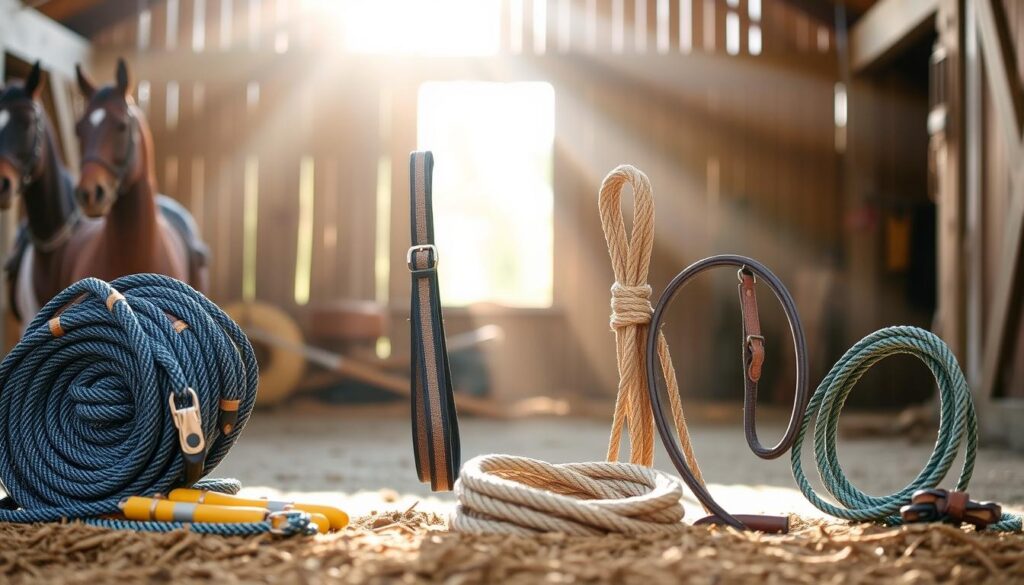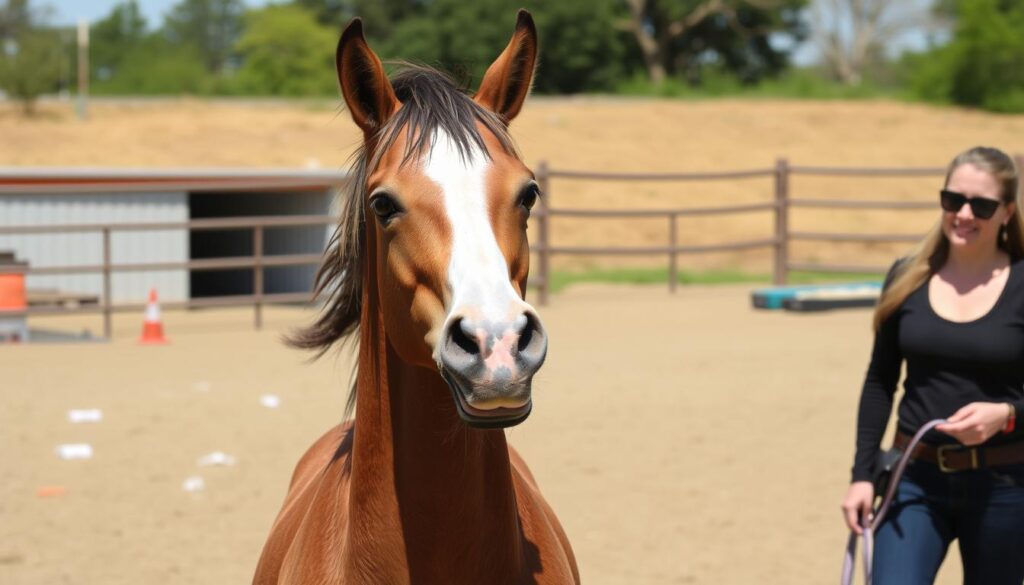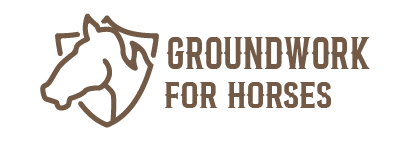Start groundwork with my horse to establish a lasting bond and foundation for training. These essential ground exercises help develop mutual trust and respect, setting the stage for successful horsemanship.
Groundwork is key for beginners. It lays a solid foundation for your horse’s training. This is essential for a strong bond.
Groundwork in English disciplines might be rare, but it’s vital in Western horsemanship. Always start at a walk. Trotting comes later, after mastering walking. This keeps things calm and controlled.
Learning to start groundwork with your horse is easy. Just follow a direct instructional approach. Use a “how-to” format to guide you.
With patience and consistency, you can build a respectful relationship with your horse. This improves their handling and performance. It’s a key part of horse groundwork for beginners.
Table of Contents
Understanding the Importance of Horse Groundwork
As a horse owner or enthusiast, it’s key to know why horse groundwork is important. It builds trust and sets boundaries, which are vital in horse training. Adding beginner groundwork exercises to your training helps build a strong bond with your horse.
Groundwork is good for all horses, young or old. About 85% of trainers use it in their programs. It gets horses ready for riding and cuts down on bad behavior by up to 60%. Adding obstacles keeps the horse interested and engaged.
Building Trust and Respect
Building trust and respect is key in horse groundwork. You do this by setting clear rules, talking well, and making a safe place. This way, you and your horse can have a great time and learn well together.
Establishing Leadership
Being a leader is also important in horse groundwork. You need to set clear rules and know what your horse needs and feels. Being a strong leader makes your horse feel safe and confident, helping in training.
Essential Safety Measures Before You Start
Working with my horse needs safety first. This keeps both the horse and handler safe and happy. About 80% of horse accidents happen on the ground, not while riding.
Wearing the right clothes is key. This means closed-toe shoes or boots with a heel. They can cut foot injuries by 70%.
A safe place for training is also important. Pick a spot without hazards to lower accident chances by 60%. A good lead rope helps too. It can make handling safer by 65%.
Knowing your horse’s signs is important. Stay ready for sudden moves. This can cut down reaction time by 50%.
Here are some safety tips for working with my horse:
* Wear the right clothes, like a helmet and boots
* Make sure the horse has a halter and lead rope
* Choose a safe area for training
* Use a quality lead rope
* Be ready for sudden moves
Required Equipment for Horse Groundwork Training
Using the right tools is essential for success in beginner groundwork exercises for horses. Proper equipment, such as a well-fitted halter, lead rope, and training aids, ensures safety and effective communication during these foundational exercises. By equipping yourself with the correct tools, you can confidently guide your horse through beginner groundwork exercises for horses, helping them develop trust, respect, and responsiveness.
A good halter is vital. You can pick from rope or leather. Rope halters are best because they help horses respond naturally. Prices vary, with some costing $36.50 and others $18.50.
Basic Equipment List
- Halter: A rope halter is recommended for its natural design and effectiveness in horse groundwork training.
- Lead rope: A 12-15 foot lead rope is a good starting point for beginner groundwork exercises.
- Flag: A flag can be used to help your horse become desensitized to new objects and sounds.
It’s important to fit the equipment right. Start with 12-foot ropes to avoid tangling. As you get better, use longer ropes for more freedom in your exercises.

Optional Tools and Their Uses
There are extra tools that can help in training. A handy stick, like the Clinton Anderson handy stick, guides your horse. But remember, using the equipment well is more important than the equipment itself, as Tik Maynard says.
| Equipment | Price | Description |
|---|---|---|
| Clinton Anderson knotted rope halter | $36.50 | A high-quality rope halter designed for horse groundwork training. |
| Knotty Girlz rope halter | $18.50 | A more affordable alternative to the Clinton Anderson halter. |
| Clinton Anderson handy stick | $61.90 | A handy stick designed for guiding and communicating with your horse. |
Reading Your Horse’s Body Language
When working with my horse, it’s key to understand their body language. This helps make a safe and effective place for handling them. Horse body language shows feelings like fear, anxiety, and calmness. Knowing these signs helps build trust and respect.
Important signs include ear position, tail swishing, and how they stand. A horse with ears forward and relaxed is calm. But, a horse with ears back and tense might be scared or worried. By noticing these signs, you can make things better for your horse.
To get better at reading horse body language, try these tips:
- Watch how your horse acts and looks in different situations
- Learn to spot signs of fear, worry, and calmness
- Change how you act to make a safe and supportive space for your horse
By using these tips and respecting your horse’s body language, you can strengthen your bond. Always put your horse’s safety and happiness first. If you’re not sure about horse handling or behavior, get help from a pro.
| Signs of Horse Body Language | Meaning |
|---|---|
| Ears forward and relaxed | Calm and relaxed state |
| Ears back and tense | Fear or anxiety |
| Tail swishing | Irritation or frustration |
How to Start Groundwork With My Horse: First Steps
To start groundwork with my horse, begin calmly and quietly. This first step builds a connection and sets the training tone. Move slowly when you approach the horse to help them feel at ease.
After you’ve reached the horse, start with simple leading exercises. These help the horse learn to follow you and understand your cues. Lead the horse in a straight line first, then add turns and stops. Always praise and treat the horse when they do well.
Teaching personal space is also key for beginners. It sets boundaries and keeps everyone safe. Personal space exercises help the horse know what’s expected and strengthen your bond.
Here are some important tips for starting groundwork with your horse:
- Move slowly and deliberately to avoid startling the horse
- Use clear and consistent cues to communicate with the horse
- Reward the horse with praise and treats for correct responses
- Gradually introduce new exercises and challenges to avoid overwhelming the horse
By following these steps and tips, you can start groundwork with your horse. This will help build a strong and respectful relationship. Always put the horse’s safety and well-being first. If you’re unsure, ask a professional trainer for help.
Basic Ground Control Exercises
Working with my horse starts with a strong foundation. These exercises make the horse more responsive to cues. This is key for handling and training.
Teaching the horse to back up with a light shake of the lead rope is important. It’s a basic skill for controlling the horse.
Lunging is another key exercise. The horse must yield its shoulder and turn away without moving towards the handler first. This shows the horse’s mental state and needs a long lunge line. Regular lunging before riding helps spot issues and makes the horse more responsive.
Some key exercises to do with your horse are:
- Yielding to physical aids, such as a halter and lead rope
- Responding to verbal cues and body language
- Backing up upon a light shake of the lead rope
- Lunging and yielding to driving aids
Doing these exercises daily improves your horse’s balance, flexibility, and responsiveness. It makes working with my horse easier and builds a strong, respectful bond.
Advanced Groundwork Techniques
As you get better at horse groundwork, it’s time to try harder things. Techniques like lunging and desensitization training make your horse better. They help with balance, awareness, and how well they listen.
Groundwork also includes driving basics. This makes your horse perform better and safer.
Some key advanced groundwork techniques include:
- Lunging fundamentals: teaching your horse to move in a circle while maintaining a consistent pace and direction.
- Desensitization training: introducing your horse to new objects, environments, and stimuli to improve their confidence and calmness.
- Ground driving basics: teaching your horse to respond to cues and move in a straight line while being driven from the ground.
Using these advanced techniques can make your bond stronger. It also makes your horse better and safer. Always be calm and patient. Reward your horse for good behavior.
Common Groundwork Mistakes to Avoid
When working with my horse, it’s key to know common mistakes. These can slow down training and hurt our bond.
Some mistakes are timing issues and pressure problems. Timing mistakes happen when we don’t read the horse’s signs. Pressure problems occur when we push too hard, making the horse scared or resistant.
Timing Issues
Timing is very important in horse training. If we press too soon or too late, it confuses the horse. This can cause bad behaviors.
Pressure Problems
Too much pressure hurts the horse’s trust. We must use soft and clear signals to talk to them.
Consistency Errors
Being consistent is vital in training. If we give mixed signals, it confuses the horse. Avoiding these mistakes helps us build a strong bond with our horses.
Knowing these mistakes helps us avoid them. This makes training better and more positive. Remember, patience, consistency, and clear communication are key when working with my horse.
Troubleshooting Difficult Behaviors
When working with my horse, it’s key to spot signs of trouble like fear or aggression. These issues can be tough to fix, but the right steps can make things better. This way, both the horse and handler can feel safe and supported.
To solve these problems, clear communication and consistent training are vital. Set clear rules and avoid confusing signals. Use positive methods to help your horse feel secure and trust you more.
Issues like catching, leading, and lunging can pop up. Finding the root cause and making a special training plan is key. For example, if catching is hard, build trust and follow a routine.

Being patient and gentle helps your horse get past tough behaviors. Stay calm, keep things consistent, and always put your horse’s safety first.
Conclusion: Building a Strong Foundation Through Groundwork
Building a strong groundwork foundation is key to successful horse training. It starts with trust, respect, and clear communication. This creates a solid base for your partnership.
Groundwork exercises make handling safer and improve your horse’s health and fitness. They also make your horse more responsive.
Investing time in groundwork greatly impacts your horse’s growth and performance. It teaches basic manners and advanced techniques. This approach helps build a harmonious relationship with your horse.
Understanding your horse’s behavior is essential for effective communication and training. Horses are complex and have unique needs.
By practicing groundwork regularly, you’ll build a strong foundation. This supports your horse’s growth and your riding success. Enjoy the journey and the rewarding experience of working with your horse.
FAQ
What is the importance of groundwork in horse training?
Groundwork is key to a strong bond between horse and handler. It builds trust and clear communication. This is vital for safe and effective handling and riding.
What are the basic steps to start groundwork with my horse?
To start groundwork, approach your horse calmly. Then, connect through basic leading. Lastly, practice personal space to keep a safe distance.
What safety measures should I take before starting groundwork?
Wear a helmet and boots for safety. Make sure the horse has a good halter and lead rope. Also, remove obstacles and have a clear path.
What equipment do I need for horse groundwork training?
You’ll need a halter, lead rope, and maybe a flag or whip. Make sure everything fits well for the horse’s comfort and safety.
How can I read my horse’s body language during groundwork?
It’s important to understand your horse’s body language. Look for signs of fear, anxiety, or calm. This helps create a safe space for your horse.
What are some basic ground control exercises I can practice with my horse?
Start with yielding to aids like a halter and lead rope. Use a flag or whip for guidance. Clear communication is key.
What are some common groundwork mistakes I should avoid?
Avoid using too much pressure and being inconsistent. Clear communication and body language cues are essential.
How can I troubleshoot difficult behaviors during groundwork?
Recognize and respond to your horse’s body language. Create a safe space and be consistent. Addressing the cause, not just the symptom, helps solve problems.

